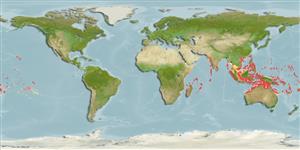Common names from other countries
>
Perciformes/Scorpaenoidei (Scorpionfishes) >
Scorpaenidae (Scorpionfishes or rockfishes) > Scorpaeninae
Etymology: Sebastapistes: Greek, sebastes = august, venerable + Greek apistia, -as = distrust (Ref. 45335).
Environment: milieu / climate zone / depth range / distribution range
Ecología
marino asociado a arrecife; rango de profundidad 2 - 61 m (Ref. 48236). Tropical; 23°N - 24°S
Indo-Pacific: Mauritius and the Comoro Islands to Pitcairn, north to the Hawaiian Islands.
Tamaño / Peso / Age
Maturity: Lm ? range ? - 2.4 cm
Max length : 4.7 cm TL macho / no sexado; (Ref. 90102)
Espinas dorsales (total) : 12; Radios blandos dorsales (total) : 9; Espinas anales: 3; Radios blandos anales: 5. Eye not extending above the dorsal profile of the head. Large pores of the cephalic lateralis system, nasal pore above and adjacent to posterior nostril with a very small retrorse nasal spine (may be absent) on its upper edge. Low ridge like spines dorsally on the head. Preocular spine embedded; sphenotic spines absent or embedded; and postorbital spines absent. Posterior lacrimal spine projecting slightly anteriorly, and a single spine posteriorly on the suborbital ridge with a pore-associated spine just below the ridge under the posterior third of the eye (Ref. 48236).
Found in areas with rubble or mixed sand and rubble, within or near coral reefs (Ref. 48236, 58302). Benthic (Ref. 58302). Feeds on small fishes (Ref. 89972). Venomous spines (Ref. 1602). Solitary (Ref 90102).
Life cycle and mating behavior
Maturities | Reproducción | Spawnings | Egg(s) | Fecundities | Larva
Randall, J.E. and S.G. Poss, 2002. Redescription of the Indo-Pacific scorpionfish Scorpaenopsis fowleri and reallocation to the genus Sebastapistes. Pac. Sci. 56(1):57-64. (Ref. 48236)
IUCN Red List Status (Ref. 130435)
CITES (Ref. 128078)
Not Evaluated
Human uses
Herramientas
Special reports
Download XML
Fuentes de Internet
Estimates based on models
Preferred temperature (Ref.
115969): 25.4 - 28.9, mean 27.6 (based on 494 cells).
Phylogenetic diversity index (Ref.
82804): PD
50 = 0.5010 [Uniqueness, from 0.5 = low to 2.0 = high].
Bayesian length-weight: a=0.01259 (0.00606 - 0.02615), b=3.03 (2.86 - 3.20), in cm Total Length, based on LWR estimates for this (Sub)family-body shape (Ref.
93245).
Nivel trófico (Ref.
69278): 3.4 ±0.6 se; based on size and trophs of closest relatives
Resiliencia (Ref.
120179): Alto, población duplicada en un tiempo mínimo inferior a 15 meses (Preliminary K or Fecundity.).
Fishing Vulnerability (Ref.
59153): Low vulnerability (10 of 100).
